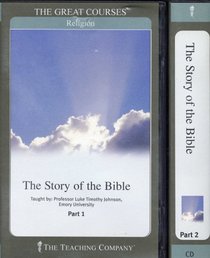Dr. Johnson makes an interesting point that the Jews wrote in Hebrew and it was then translated to Greek. The Christians, when they wrote the New Testament, used the Greek older works, not the original Hebrew. When someone translates from one language to another, things are lost and sometimes gained. However, as books are translated from one language to another, and then another, meaning can be lost or changed because of the differences in languages.
At the time of the Bible, the world was dominated by Greco-Roman culture; meaning, Greek culture and Roman rule. The author tells about how the history of the Holy Roman Church vs. the Byzantine Church began to diverge (Romans spoke and wrote in Latin; Byzantines spoke and wrote Greek) along cultural lines. The Roman Empire also had political and religious powers while the Byzantines stayed in the religious realm.
The very interesting story of how the Bible evolved over generations and centuries is told in these 24 lectures. Dr. Johnson tells everything from how the paper changed to how it was interpreted differently over the centuries. With the Guttenberg Bible and increased literacy, the book was more widely available and with that came increased numbers of interpretations and study. That brought about the Reformation; no longer could the prelates (formerly the only ones able to read) be the only disseminators of the Bible's knowledge.
A fascinating tidbit: When the Bible was being translated to all these different languages, sometimes the scribes had to invent the written language to which it was being translated! In other words, the scribes created the written language to fit the oral tradition (the oral tradition that might be centuries old). Chapter-and-verse markings weren't added to the Bible until about 1565 CE. Can you imagine finding a favorite passage you were looking for in the Bible before that time? Another point was that with the Guttenberg press, the Bible could be stabilized; prior to this, there were many interpretations floating around.
The story of how the King James Version of the Bible was written is quite interesting (lesson 18). The discussion of Judaism after the Holocaust is really important reading and understanding. It is really provocative (lesson 22). Dr. Johnson is a wonderful presenter and I learned so much.
The Names of the Lessons; They Are Much More Interesting Than These Titles Indicate
1. Telling the Story of a Book
2. Making TaNaK
3. Forms of Jewish Scripture
4. Birth of the Christian Bible
5. Formation of Jewish and Christian Canons
6. Writing and Copying Manuscripts
7. Imperial Sponsorship and the Bible
8. Texts and Translations - The Ancient East
9. Old Latin and the Vulgate
10. Other Ancient Versions
11. Monasteries and Manuscripts
12. Interpretation within Judaism
13. Interpretation in Medieval Christianity
14. The Renaissance, Printing, and the Bible
15. The Protestant Reformation and the Bible
16. Translating the Bible into Modern Languages
17. The First Efforts at Englishing the Bible
18. The King James Version
19. The Romance of Manuscripts
20. Searching for the Critical Text
21. The Historical-Critical Approach
22. The Bible in Contemporary Judaism
23. Contemporary Christians and Their Bibles
24. The Bible's Story Continues
At the time of the Bible, the world was dominated by Greco-Roman culture; meaning, Greek culture and Roman rule. The author tells about how the history of the Holy Roman Church vs. the Byzantine Church began to diverge (Romans spoke and wrote in Latin; Byzantines spoke and wrote Greek) along cultural lines. The Roman Empire also had political and religious powers while the Byzantines stayed in the religious realm.
The very interesting story of how the Bible evolved over generations and centuries is told in these 24 lectures. Dr. Johnson tells everything from how the paper changed to how it was interpreted differently over the centuries. With the Guttenberg Bible and increased literacy, the book was more widely available and with that came increased numbers of interpretations and study. That brought about the Reformation; no longer could the prelates (formerly the only ones able to read) be the only disseminators of the Bible's knowledge.
A fascinating tidbit: When the Bible was being translated to all these different languages, sometimes the scribes had to invent the written language to which it was being translated! In other words, the scribes created the written language to fit the oral tradition (the oral tradition that might be centuries old). Chapter-and-verse markings weren't added to the Bible until about 1565 CE. Can you imagine finding a favorite passage you were looking for in the Bible before that time? Another point was that with the Guttenberg press, the Bible could be stabilized; prior to this, there were many interpretations floating around.
The story of how the King James Version of the Bible was written is quite interesting (lesson 18). The discussion of Judaism after the Holocaust is really important reading and understanding. It is really provocative (lesson 22). Dr. Johnson is a wonderful presenter and I learned so much.
The Names of the Lessons; They Are Much More Interesting Than These Titles Indicate
1. Telling the Story of a Book
2. Making TaNaK
3. Forms of Jewish Scripture
4. Birth of the Christian Bible
5. Formation of Jewish and Christian Canons
6. Writing and Copying Manuscripts
7. Imperial Sponsorship and the Bible
8. Texts and Translations - The Ancient East
9. Old Latin and the Vulgate
10. Other Ancient Versions
11. Monasteries and Manuscripts
12. Interpretation within Judaism
13. Interpretation in Medieval Christianity
14. The Renaissance, Printing, and the Bible
15. The Protestant Reformation and the Bible
16. Translating the Bible into Modern Languages
17. The First Efforts at Englishing the Bible
18. The King James Version
19. The Romance of Manuscripts
20. Searching for the Critical Text
21. The Historical-Critical Approach
22. The Bible in Contemporary Judaism
23. Contemporary Christians and Their Bibles
24. The Bible's Story Continues




